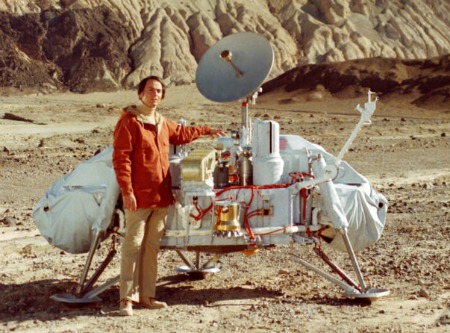The question of whether there is life on other planets took a fresh turn this week as new analysis of old data collected by the Viking Landers in 1976 found signs of extant microbes on Mars. Back in the day one test yielded promising results, but another experiment found no organic compounds consistent with life, so mission scientists assumed the former was a simple oxidizing reaction and not a biological one. That’s where the new analysis comes in:
(ScienceBlog) — Miller and colleagues did not accept this interpretation, and over the last six years applied measures of mathematical complexity to the data from active and control Viking data, as well as terrestrial biological and non-biological data sets. Not only did the active Viking LR experiments exhibit higher complexity than the control experiments, but the active experiments clearly sorted with terrestrial biological data series whereas the Viking LR control data sorted with known terrestrial non-biological data.
“To paraphrase an old saying, if it looks like a microbe and acts like a microbe, then it probably is a microbe,” said Miller, who is a neuropharmacologist, but also studies circadian rhythms at USC and is an author on the research. “The presence of circadian rhythmicity and a high degree of mathematical complexity or order in the LR data most likely means Viking discovered microbial life on Mars over 35 years ago.”
It’s unfortunate that in all of the dozen comprehensive Mars missions, not one has been equipped with a medium power microscope to examine soil samples and not one has returned samples to earth for close scrutiny. And there may not be one in the near future if the recent austerity cuts to planetary science stand.


Can we just take the money from the presidential campaigns and give it to NASA?
Win-Win!
This is cool research, I hope it proves more fruitful in the near future!
Ever since I was a kid…
I have always thought that Viking actually got it right first time around!
I hope Curiosity can finally confirm such a stupendous and game changing discovery!
leftwingfox @ 3
Phobos-Grunt was a russian probe that was designed to land on one of the Martian moons and return a sample…unfortunately a programming error apparently which led to a simultaneous reboot of two working channels of an onboard computer.
It stalled itself affectively by a badly written command data string.
(Microsoft eat ya heart out!)
But that is as near as it has been…but next decade might see a mission for just that idea.
40 years ago I worked in the clean room at Martin-Marietta and assembled the soil sampling computers for Viking. 40 IC’s per circuit board at $1000 each were soldered very carefully with company QC and Air Force QC looking over my shoulder. The first board I completed was hooked up wrong according to engineering and fried the board, the test specifications were changed. So I made 5 boards instead of the required 4. 1 to test and destroy, 2 for flight and 1 for back-up. The Back-up is at the Smithsonian. I also worked on Skylab.
Kind of big news. I’ll be watching for follow up.
Manned missions to Mars are considered “important” while sending advanced robots isn’t?
Too many people want to use science as ego and nationalism instead of enlightening ourselves.